Free Courses Sale ends Soon, Get It Now


Free Courses Sale ends Soon, Get It Now


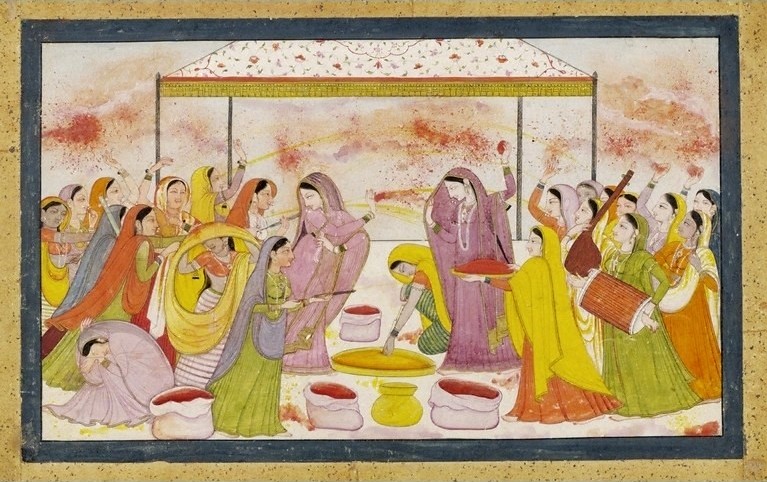
Disclaimer: Copyright infringement not intended.
Introduction
The history of painting in India goes back 2000 years, something that many do not realize, starting with the beautiful murals of Ajanta, which are interesting too because they show people wearing craft still extant. The 11th century saw the illustrated Pala manuscripts, painted on palm leaves, and the earliest example of miniature painting in India. The next development was the Jain school of Gujarat, which eventually lead to the Rajput tradition of miniature art. As it grew and developed, the Rajput tradition divided into two distinct schools, Rajput and the Pahari school, based in Himachal Pradesh, the hilly state in the North-West of India.
Pahari Paintings
The Pahari miniature painting school flourished in the foothills of the Himalayas in the northern states of Himachal Pradesh, Jammu & Kashmir and Uttarakhand from around the 16th century. The earliest surviving paintings from the school is the mid-16th century manuscript of the “Devi Mahatmya” illustrating early Rajput style of art, currently preserved in the Shimla museum. With patronage from the rulers of 30-odd Pahari kingdoms that existed in the region, the Pahari miniature school progressed and the art form reached its peak popularity between the 17th and 19th centuries.
Similar in style to the Rajasthani miniatures, a Pahari miniature painting usually begins with combining sheets of paper to achieve an appropriate thickness followed by an outlining, usually done with a dark colour and finally the colours are laid on. Unlike a modern-day artist’s brush, the painters of the epoch had to make their brushes from horse hair or feathers of local birds. Exquisitely so, the use of gold dust and river stone was made to brighten the painting and peculiarly so, a poison derived from the poisonous plants was also utilised to prevent the paintings from decaying.
With their own uniqueness, a variety of styles surfaced but the two major styles whose manifestation gained recognition are Basohli and Kullu style, and Guler and Kangra style.
The Pahari artists not only attained fame but also received huge patronage from mostly the kings as they were called upon by many royal families to paint the Kings and their courts, fight scenes, armies on horses and elephants, shikar (hunting), love and other scenes. The great ruler of Kangra, Maharajah Sansar Chand (1765–1823 AD) is recognized as one of the biggest patrons of this form of art and is credited with making the Kangra school of art an eminent branch of Indian art of the period.
Pahari paintings have been widely influenced by the Rajput paintings, because of the family relations of the Pahari Rajas with royal court at Rajasthan. One can also see strong influence of the Gujarat and Deccan paintings. With the emergence of Bhakti movement, new themes for Indian Pahari paintings came into practice. The Shaiva-Shakta themes were supplemented by argot poetry and folk songs of Lord Krishna and Lord Rama. At the same time, the themes of the paintings revolved around love and devotion also. There was also illustration of great epics, puranas, etc. The depiction of Devi Mahatmya manuscript painted at Kangra, in 1552, has been much acclaimed.
The end of feudal system and independence of India signalled the end of the golden era for the Pahari school as the sole patrons of this art form disappeared from the scene and with them, even the art form seems to have died out.
Styles of Pahari Paintings
Pahari paintings of India can be divided into two distinct categories, on the basis of their geographical range, namely:
Basohli and Kullu style had its bold, intense tones blending the Hindu mythology with local folklores using the Mughal techniques. Under the patronage of Raja Kirpal Pal, the artist Devidasa painted the Rasamanjari text. In sharp contrast, the Guler and Kangra style of art focuses on cool and calm colours. The gradual decline of Basohli style gave rise to immense popularity to the Guler and Kangra style. This style of paintings mostly focused on landscapes adding elegant and graceful women in the foreground.
Types of Pahari Paintings
Basohli Paintings
The town of Basohli is situated on the bank of the Ravi River in Himachal. This town has produced splendid Devi series, magnificent series of the manifestations of the Supreme Goddess. Apart from that, it is also known for the magnificent depiction of the Rasamanjari text. Artist Devidasa painted it under the patronage of Raja Kirpal Pal. Gita Govinda of 1730 is also believed to have Basohli origin. Geometrical patterns, bright colors and glossy enamel characterize Basohli paintings.
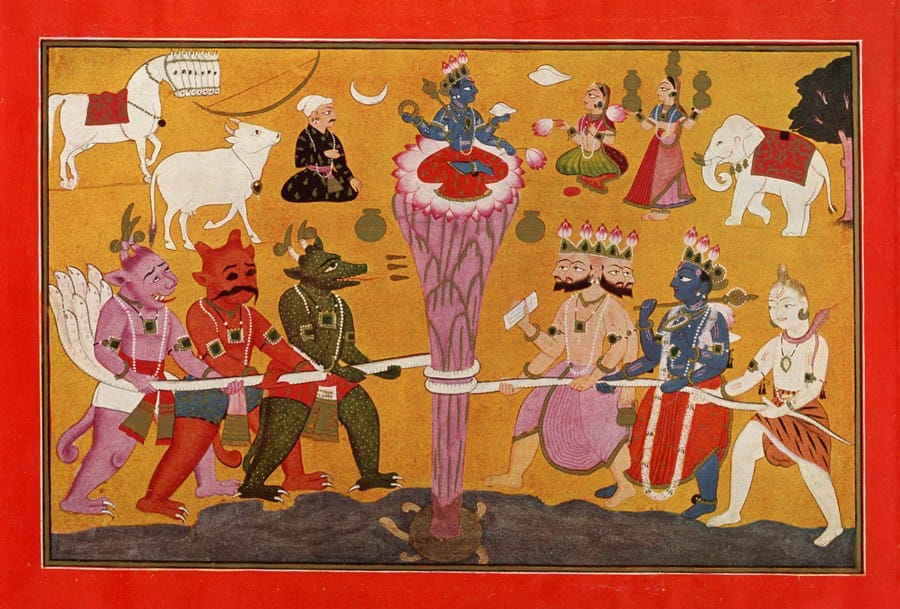
Basohli school is the earliest noteworthy trend of the genre and is distinct from the others in its simplicity of composition and its bold flat colors. Backgrounds tend to be monochromatic and facial features are stylized, with long almond-shaped eyes. The Basohli school is the least developed and sophisticated of the Pahari school, understandably so.
Bilaspur Paintings
Bilaspur is situated in Himachal Pradesh in Satluj valley. Bilaspur witnessed the growth of the Pahari paintings around the mid-17th century. Apart from the illustrations of the Bhagavata Purana, Ramayana and Ragamala series, artists also made paintings on rumal (coverlets) for rituals and ceremonies. Besides these, painters at Bilaspur also executed paintings on coverlets for ceremonies and rituals.
The faces are now naturalistic, yet they belong to a particular style or tradition an unusually sweet type which would continue to the last paintings of this school. The treatment of landscape is more idealized and rich and introduces a number of decorative trees and shrubs. Its slate gray trunks are heavily muddled and stylized. These paintings have a porcelain quality. They are warm in expression. Every detail is made luminously decorative. Lush vegetation is shown with knotted tree trunks. Bilaspur painters show a preference for gold which is frequently used here; even the gray patches on Cows are picked out with gold. A fine leaf' from the Tehri-Garhwal Palace collection, illustrating the game of "Blindman's buff", is strikingly similar to the Bhagavata group of Bilaspur paintings.
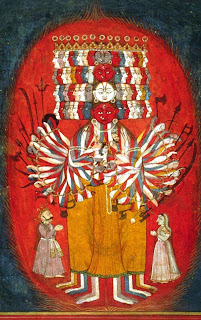
Bilaspur was as the centre of painting the seventeenth century. It was overshadowed by Basohli (a state that was neither very rich nor very large).
Chamba Paintings
Chamba paintings are quite similar in appearance to Mughal style of paintings, with strong influences of Deccan and Gujarat style also. The late 17th century witnessed Chamba paintings of Himachal being dominated by Basohli style, which ultimately gave way to Guler painting tradition. Chamba is known for its typical and distinctive female figures endowed with the most charming appearances. Chamba is outstanding in its technique of artistically mixing colours and amplifying their visual impact. The paintings endow exceptionally delicate colouring, fine draughtsmanship, an unusual refinement of lines and a sensitive treatment of landscape.

The miniature artists illustrated Hills, Shrubs, flowering trees of the region but unruffled them according to their own choice. To a Pahari Painter, nature and art are, of course, connected, but not in the strict model and copy relationship.

The scenic setting inspired the painters to paint in delicate harmonies. The rounded hillocks, with little blobs of green paint shaped like trees may be recognized as simplified landscape motifs. Miniatures vibrate with realism, natural emotions and their colours echo with softness of music. The use of primitive colours- red, yellow and blue, plain or decorative fine borders, carefully brushed jewellery, neatly laid buildings and richly relieved landscape balanced with contrasting colours and consisting of superbly treated nature — trees, leaves, flowers, shrubs, birds and hills. Glorification of female beauty, in all its charming details is other peculiar trait of the miniature painters.
PAPER: Layers of Sialkoti paper are used to paint on. Sialkot is a place, now in Pakistan, where such papers were produced in large quantities. Handmade sheets are used to paint on because they absorb colours, so they penetrate deep into it.
BRUSHES: Miniature artists in the past used to prepare these brushes themselves as per their convenience and requirement. They were made of ear hair of mongoose, goat/ buck and calf; while for details and outlines brushes made of squirrel’s hair were used which are so fine that each hair can be seen separately. The material used for brushes are still much the same, but they are now available in the market.
PAINTS: Paints used in these paintings are made of three kinds of pigments:-
Garhwal Paintings
Garhwal Paintings originated in Himachal and were first dominated by the Mughal style. Later, it started reflecting the cruder version of Kangra traditions.
History
About the middle of the 17th century AD Sulaman Shikoh, a Mughal Prince, took refuge in Garhwal. The Prince brought along with him an artist and his son who were his court painters and well versed in the Mughal Style of Miniature painting. After nineteen months, the prince left Garhwal but his court painters enchanted by the environs, stayed behind. These painters settled in Srinagar, Garhwal, and the then capital of the Panwar dynasty and introduced the Mughal style of painting in Garhwal, Uttaranchal. With the passage of time, the successors of these original masters became expert painters and also developed an original style of their own using very natural colours. This style later on came to be known as the Garhwal School of painting.
About a century later, a famous painter, Mola Ram developed a style of painting equalled in romantic charm only by few other styles of painting. Special features of the Garhwal School include beautiful women with fully developed breasts, thin waist line, soft oval shaped force, delicate brow and thin nose with definite nose bridge with a warm and cold colour range of harmonies.
Further, the matrimonial alliance of King Pradhyuman Shah (1797-1804 AD) with a Guler Princess of Kangra induced many Guler artists to come and reside in Garhwal. Their technique greatly influenced the Garhwal style of painting. With the conceptualisation of ideal beauty, its fusion of religion and romance, its blending of poetry and passion, the paintings of Garhwal are an embodiment of the Indian attitude towards love.
Of all these, Mola Ram has carved a niche for himself in the history. He laid the foundation for the Garhwal School of Painting.
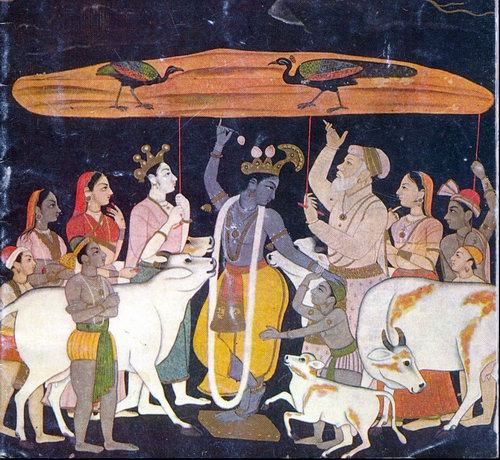
Special Features
The distinctive features of the Garhwal School of Painting consist of extremely beautiful and near perfect women with high arched, thin and delicate looking eyebrows and a captivating nose with a defined nose bridge resting on a supple oval face. The build of the female would usually have a tiny waist emphasized by the greatly developed bosom. This envisioning of the ideal beauty was on metaphorical terms that blended poetry and passion with romance and sometimes religion. It showed the unblemished approach towards finding that unabashed and spiritual love in India at that time.
The most colourful masterpieces of the Garhwal School of painting include the following:
Guler Kangra Style Paintings
The pictorial art of Kangra is one of the finest gifts of India to the art-world. This great art originated in a small hill state ‘Guler’ in the Lower Himalayas in the first half of the eighteenth century when a family of Kashmiri painters trained in Mughal Style of painting sought shelter at the court of Raja Dalip Singh (r. 1695-1741) of Guler. The new arrivals mingled with the local artists and were greatly influenced by the atmosphere of the hills. Instead of painting flattering portraits of their masters and love scenes, the artistes adopted themes of eternal love between Radha and Krishna. The paintings were naturalistic and employed cool, fresh colors. The colors were extracted from minerals, vegetables and possessed enamel-like luster. Verdant greenery of the landscape, brooks, springs were the recurrent images on the miniatures.
This style reached its zenith during the reign of Maharaja Sansar Chand Katoch (r.1776-1824) who was a great patron of Kangra art.
Maharaja Sansar Chand was an ardent devotee of Krishna and used to commission artists to paint subjects based on the loves and life of Krishna.
The Guler-Kangra art is the art of drawing and the drawing is precise and fluid, lyrical and naturalistic. In these styles the faces are well modelled and shaded so judiciously that they possess almost porcelain-like delicacy.
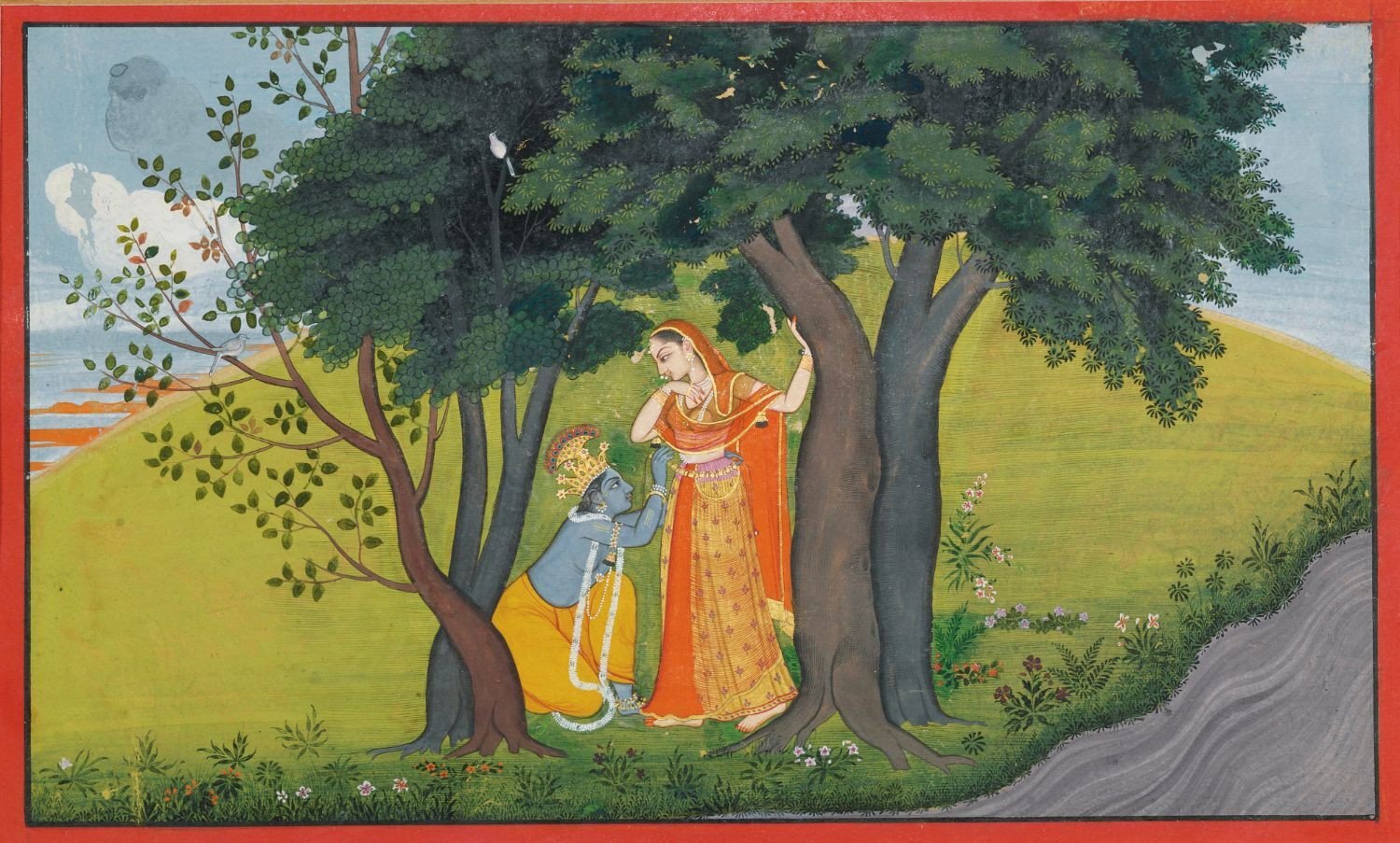
The focal theme of Kangra painting is Sringar (the erotic sentiment). The subjects seen in Kangra painting exhibit the taste and the traits of the life style of the society of that period. Bhakti cult was the driving force and the love story of Radha and Krishna was the main source of spiritual experience, which was also the base for the visual expression. Bhagvata Purana and the love poems Gita-Govinda of Jaidev were the most popular subjects dealing with the legends and the amorous plays of Radha and Krishna symbolising soul’s devotion to God. In some miniatures, the blue-god Krishna is seen dancing in the lush woodlands and every maiden’s eye are drawn to him. Krishna subjects, known commonly as Krishna-lila predominate, while the themes of love, inspired by the nayaks and nayikas and baramasa enjoyed great favour. The sentiment of love remained the inspiration and the central theme of Pahari painting.
The Kangra miniatures are noted for portraying the famine charm with a natural grace. Apart from female beauty there is also a loving interest in landscapes, the countryside, the rivers, trees, birds, cattle, and flowers which have been very meticulously portrayed in these paintings.
The Kangra painting excels in the female figures, which were generally conceived as the embodiments of youth, beauty and emotive sentiment. The figure of youthful coy nayika seen in Kangra miniatures is an ideal physical type which is slender and elegant, radiating infinite charm, sensitiveness and refinement.
The colour scheme of Kangra painting appears to be toned down in such a way that it looks soft, cool but brilliant and cheerful. At the zenith of its refinement, Kangra painting presents a pure melody of flowing lines and glowing colours, breathing out a sense of space, tranquillity and poetic sentiment.
The prominent artist of the Kangra school is Purkhu, whose paintings are full of human figures, in court and subjects like the Gita Govinda, yet never crowding the canvas. His depictions of nature based on the beauty of Himachal Pradesh are remarkable, too, as are his precise details of the apparel worn at the time.
Jammu Paintings
Jammu paintings of the late 18th and early 19th century bear a striking similarity to the Kangra style. Shangri Ramayana of the late 17th and early 18th century was produced in Jammu itself.
Jasrota Paintings
Jasrota paintings are mainly found in Jammu and Kashmir and revolve around court scenes, events from the life of the kings, allegorical scenes, etc. Jasrota, located in Jammu and Kashmir, saw some noteworthy works of art executed by Nainsukh of Guler.
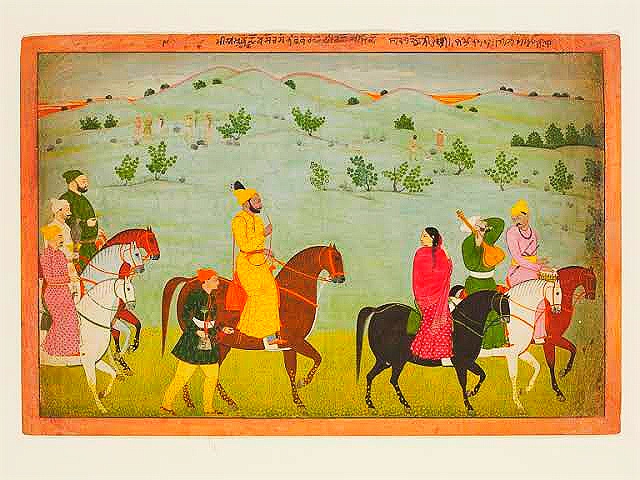
Under Raja Balwant Singh (1724-63) , Nainsukh produced portraits, court scenes, events from the prince’s life.
Kulu Paintings
The later half of the 18th century is the glorious period for Kulu style paintings. The style followed in the series Ragamala, the Bhagawad Purana and Madhu-Malti. Human figures are short but not heavy. They seem to be slow moving and their wide open eyes give them a doll like look. The costumes of females are also different from other style of pahari paintings, particularly in the treatment of scarves (odhanis), which is worn in different way. Female dresses are often dotted. Male costumes are more or less similar to that in other pahari styles, and turban is of Katoch type. This Katoch turban shows an indirect influence of the Kangra style on the Kulu paintings.
Sultanpur Palace is an architecturally beautiful palace in Kulu. It is one of the major attractions in valley. It is well-known for some beautiful miniature paintings in Kulu style. The paintings are based on simple themes showing rural backgrounds without human figures in them. The paintings of Kulu style include a Bhagavata Purana, two Madhumalati manuscripts etc.
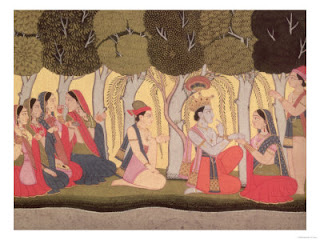
Mandi Paintings
Mandi, situated in Himachal, witnessed the evolution of a new style under Raja Sidh Sen (1684-1727). During that time, the portraits depicted the ruler as a massive figure with overstated huge heads, hands and feet. Other works were characterized by geometric compositions and delicate naturalistic details.
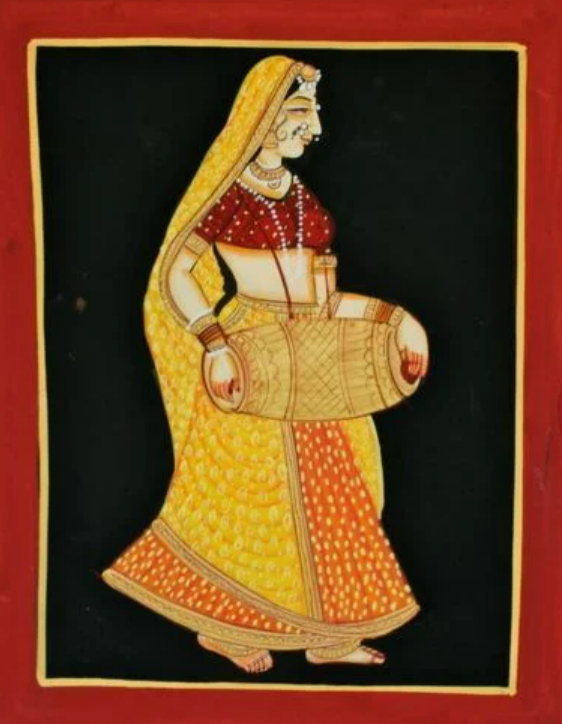
Mankot Paintings
Mankot paintings of Jammu and Kashmir bear a resemblance to the Basohli type, with vivid colors and bold subjects. In the mid-17th century, portraitures became a common theme. Episodes from the life of Krishna, as told through the 10th book of the Bhagavata Purana, were often illustrated. With time, the emphasis shifted to naturalism and subdued colors.
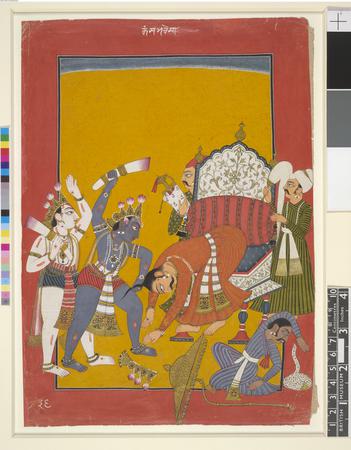
Nurpur Paintings
Nurpur paintings of Himachal Pradesh usually employ bright colors and flat backgrounds. However, in the later periods, the dazzling colors were replaced by muted ones.
Final Thoughts
Vijay Sharma, a Padma Shri awardee painter from Chamba district was recently quoted as saying that there was no government policy in place to preserve the Pahari style of paintings and that the very few teachers of Pahari paintings left were not in a position to pass on their legacy to the next generation due to lack of patronage from the government. The few families still engaged in practising the art have been reduced to making decorative panels for doors or windows and drawings.
Barely three centuries after its peak, the Pahari miniature school of painting faces an existential challenge and without immediate and significant government support or patronage by the new Maharajas of Indian business, this form could fade from the Indian canvas.
Citations
© 2024 iasgyan. All right reserved